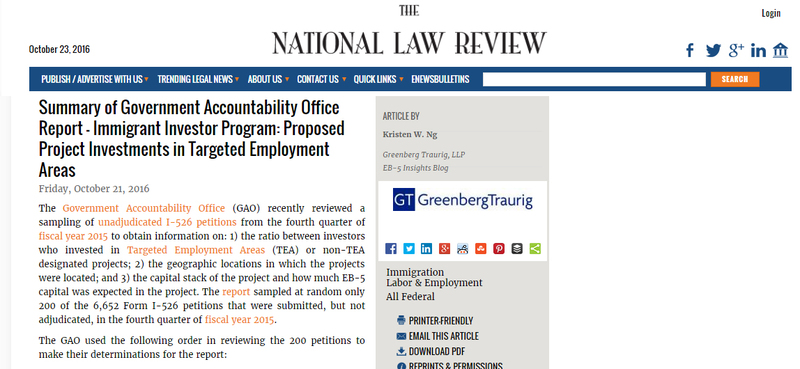The Government Accountability Office (GAO) recently reviewed a sampling of unadjudicated I-526 petitions from the fourth quarter of fiscal year 2015 to obtain information on: 1) the ratio between investors who invested in Targeted Employment Areas (TEA) or non-TEA designated projects; 2) the geographic locations in which the projects were located; and 3) the capital stack of the project and how much EB-5 capital was expected in the project. The report sampled at random only 200 of the 6,652 Form I-526 petitions that were submitted, but not adjudicated, in the fourth quarter of fiscal year 2015.
The GAO used the following order in reviewing the 200 petitions to make their determinations for the report:
- To gather data on whether the investment was made in a TEA or non-TEA, the GAO reviewed each I-526 petition to identify whether the minimum investment amount was $500,000 or $1,000,000. If the investment was $500,000, the I-526 petition was examined further to determine whether the basis of the lower investment amount was because the project was located in a rural area or a TEA.
- To gather data on the geographic areas, the GAO first looked to see if the $500,000 investment was made in a TEA. If so, the GAO reviewed the TEA letter and/or project documents to determine whether the TEA was based on a single census area or a combination of census areas.
- To estimate EB-5 capital as part of the total capital stack per project, the GAO reviewed the business plans submitted with the I-526 petitions.
The GAO’s Findings
As a result of its reviews of a random sample of 200 I-526 petitions, the GAO found the following, summarized below:
Most EB-5 Petitioners Elected to Invest in a TEA
The GAO found from their review that 96.5% of petitioners from the fourth quarter of fiscal year 2015 elected to invest in a high unemployment TEA, and thus made the minimum investment of $500,000. An additional 2.5% of petitioners elected to invest in a rural TEA with the minimum investment amount of $500,000.
Most EB-5 Petitioners Invested in a High Unemployment TEA on a Combination of Census Areas
The GAO found that of the petitioners that elected to invest in TEAs based on high unemployment, 90% of the TEAs were based on the average unemployment rate for a combination of census areas as allowed under the program. The remaining 10% of petitioners based the TEA on the unemployment rate of a single census tract, census block group, or county. The GAO also found that of the petitioners that invested in projects in high-unemployment TEAs, 65% of the TEAs combined 2 to 10 census areas, 26% combined 11 to 100 census areas, and the remaining 12% combined more than 100 census areas, as the program allows.
The GAO also reviewed the unemployment rate of the census tract in which the project was located. The GAO found that 41% of petitioners invested in projects that were located in a census tract where the unemployment rate was 4 to 6 percent.
Proportion of EB-5 Investment in Projects Compared to non-EB-5 Investment in the Project
The GAO found from the sampling of I-526 petitions that EB-5 capital in the capital stack of a project was less than non-EB-5 capital in a given project. The estimated median percentage of total EB-5 investment in projects is 29% of the total estimated project cost, and that the estimated mean percentage is 40%. Non-EB-5 sources of capital included developer equity, bank loans, land contributions, tax credits, cash from operations, and government loans and grants.
In addition, the GAO found that of the petitioners who elected to invest in a TEA, 74% of the projects were real estate projects, including mixed use, hotels and resorts, commercial, and residential development. The remaining 28% of investors elected to invest in infrastructure projects, including railways, highways, restaurants, medical, and education facilities. Please note that the figures do not total 100% due to rounding.
Characteristics of Sample Projects
The GAO released some information on the 200 I-526 petitions that were reviewed. The 200 I-526 petitions encompassed 114 unique projects that spanned 20 states, the District of Columbia, and the Northern Mariana Islands. New York, California, and Florida had the most investments of the sampling.
Mentions
States
- New York
Securities Disclaimer
This website is for informational purposes only and does not constitute an offer or solicitation to sell shares or securities. Any such offer or solicitation will be made only by means of an investment's confidential Offering Memorandum and in accordance with the terms of all applicable securities and other laws. This website does not constitute or form part of, and should not be construed as, any offer for sale or subscription of, or any invitation to offer to buy or subscribe for, any securities, nor should it or any part of it form the basis of, or be relied on in any connection with, any contract or commitment whatsoever. EB5Projects.com LLC and its affiliates expressly disclaim any and all responsibility for any direct or consequential loss or damage of any kind whatsoever arising directly or indirectly from: (i) reliance on any information contained in the website, (ii) any error, omission or inaccuracy in any such information or (iii) any action resulting therefrom.




